 BACK TO LIST
BACK TO LIST
European Renaissance Silver
The Renaissance period in Europe, spanning roughly from the 14th to the 17th century, witnessed a significant increase in the production, trade, and use of silver. Several major influences contributed to this, including economic factors, technological advancements, exploration and colonization, and the patronage of wealthy individuals and institutions.
One of the primary drivers of the increased silver production was the growing economic prosperity of Europe. The period saw the rise of powerful city-states, such as Florence and Venice, which became centres of commerce and banking. The expanding trade networks, both within Europe and with other regions like Asia and the Americas, created a greater demand for silver as a medium of exchange.
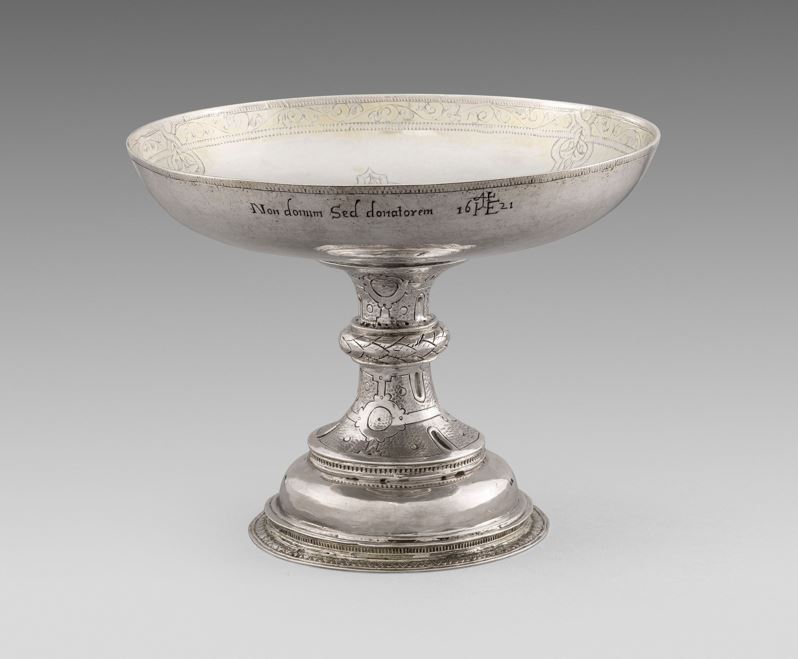
An Elizabeth I Silver Tazza London, 1571
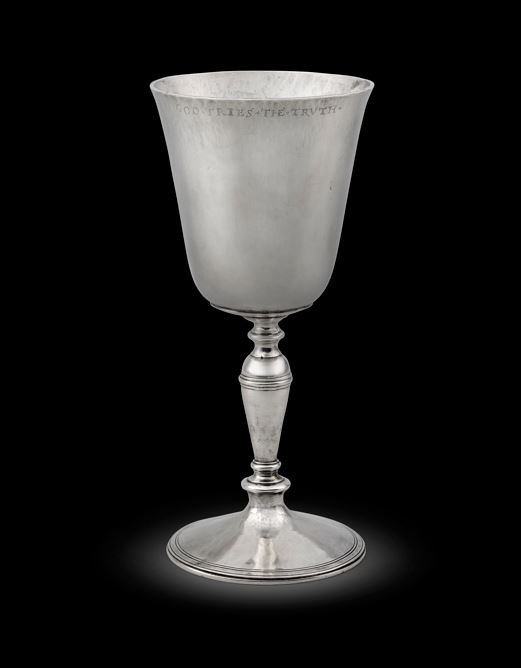
A Charles I wine cup London, 1631 Maker’s mark IH
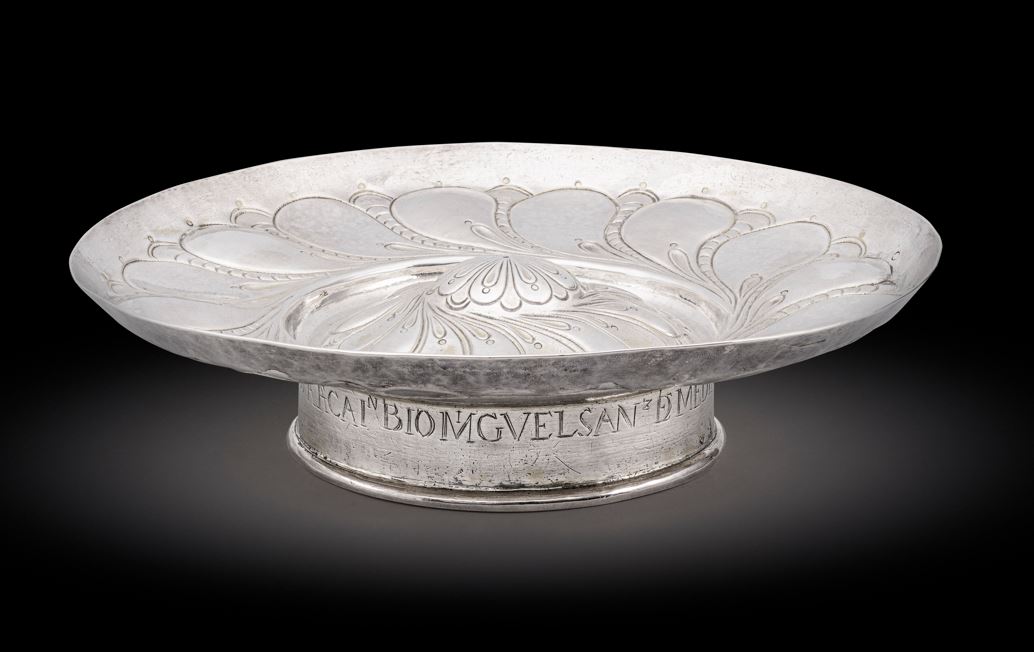
A Spanish parcel-gilt tazza Palencia, circa 1530
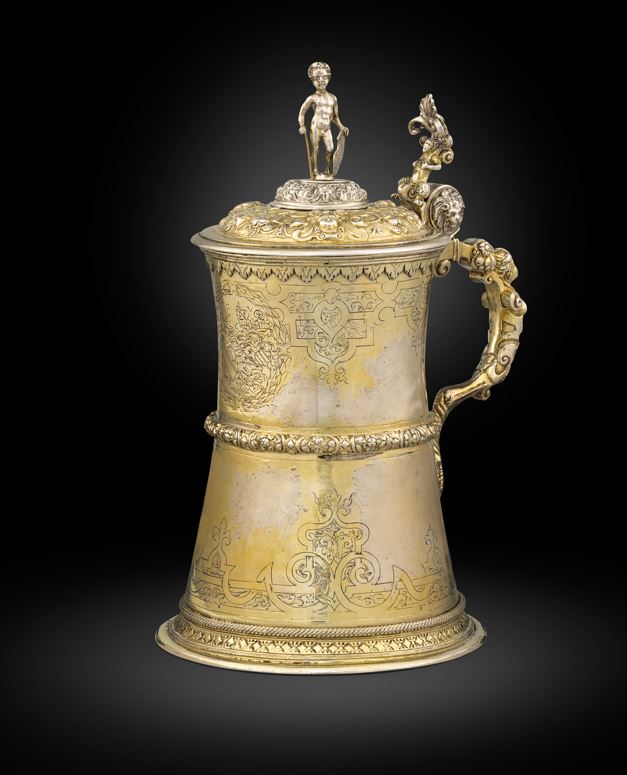
An Important 16th Century Silesian Tankard
Neisse, circa 1570
Maker’s mark of Hans Schmidt
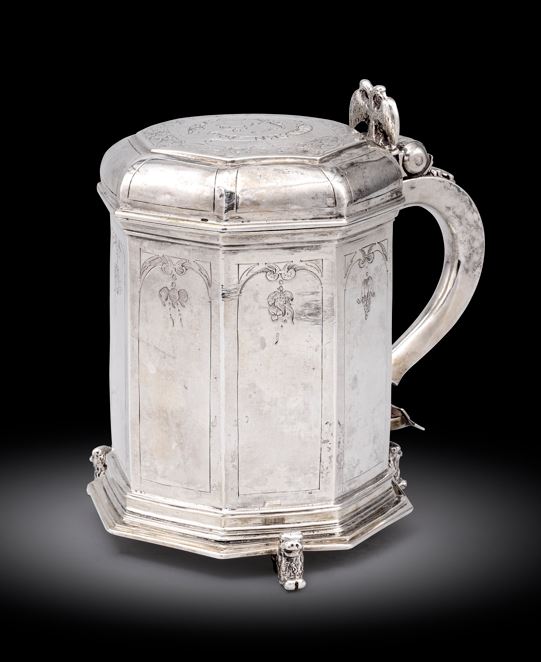
A Norwegian 17th Century Octagonal Peg Tankard
Bergen, circa 1650
Maker’s mark of Herman Wichman
One of the primary drivers of the increased silver production was the growing economic prosperity of Europe. The period saw the rise of powerful city-states, such as Florence and Venice, which became centres of commerce and banking. The expanding trade networks, both within Europe and with other regions like Asia and the Americas, created a greater demand for silver as a medium of exchange.

An Elizabeth I Silver Tazza London, 1571
The remarkable advancements in mining, refining, and minting techniques, significantly boosted production. Innovations like the adoption of hydraulic-powered machinery, such as water wheels and pumps, improved the efficiency of mining operations. Refining techniques were also improved, allowing for the extraction of higher purity silver. This in turn increased the overall supply of silver, making it more accessible for various purposes.
The Age of Discovery, starting in the late 15th century, opened new avenues for silver. European explorers and colonizers ventured into the Americas, where they discovered vast reserves of silver, particularly in regions like Mexico and Peru. The influx of American silver into Europe, known as the "Silver Drain," led to a significant increase in the availability of the metal, contributing to economic growth and inflation.
This era was characterized by a flourishing culture of patronage, with wealthy individuals, nobility, and the Church investing in art, architecture, and luxury goods. Silver, with its intrinsic value and aesthetic appeal, became a favoured material for creating elaborate and ornate objects. Silverware, tableware, jewellery, and other decorative items were produced to showcase the wealth and refinement of the patrons. This demand for luxury items further stimulated this prosperous market.
The development of modern banking and monetary systems, with silver coins playing a crucial role further influenced production too. Many European states standardized their coinage, minting silver coins of consistent weight and purity. These coins facilitated domestic and international trade, enhancing economic activity. The silver content of coins was carefully regulated to maintain their value and prevent debasement, contributing to the stability of currencies.
England
During the period 1600–1800, the production of silver in Great Britain and Ireland served a growing class of people who could afford such objects, from magnificent pieces like the illustrated Elizabethan tazza 1571, to more ordinary tablewares and personal items such as punch bowls, spoons, and snuffboxes. Economic, political, and social conditions determined the appearance and cost of silver objects made for domestic, court, and public use. From James I to George III, silver styles reflected the policies and aesthetic preferences of the sovereign: the conservatism of James in a period of high immigration of Protestants from the Continent, bringing with them skills and designs in favour there; the delicate and refined aesthetic sense of Charles I, illustrated here with this rather lovely wine cup of 1631; the puritanical outlook of Oliver Cromwell; the extravagance of Charles II and his protection of Huguenots arriving on English shores often destitute, whom he supported from the privy purse. At the same time, while London set fashions for the court and upper classes, silver continued to be made for people in ordinary walks of life, in styles that changed only slowly, represented by items such as tankards, mugs, candleholders, and the like.
The Age of Discovery, starting in the late 15th century, opened new avenues for silver. European explorers and colonizers ventured into the Americas, where they discovered vast reserves of silver, particularly in regions like Mexico and Peru. The influx of American silver into Europe, known as the "Silver Drain," led to a significant increase in the availability of the metal, contributing to economic growth and inflation.
This era was characterized by a flourishing culture of patronage, with wealthy individuals, nobility, and the Church investing in art, architecture, and luxury goods. Silver, with its intrinsic value and aesthetic appeal, became a favoured material for creating elaborate and ornate objects. Silverware, tableware, jewellery, and other decorative items were produced to showcase the wealth and refinement of the patrons. This demand for luxury items further stimulated this prosperous market.
The development of modern banking and monetary systems, with silver coins playing a crucial role further influenced production too. Many European states standardized their coinage, minting silver coins of consistent weight and purity. These coins facilitated domestic and international trade, enhancing economic activity. The silver content of coins was carefully regulated to maintain their value and prevent debasement, contributing to the stability of currencies.
England
During the period 1600–1800, the production of silver in Great Britain and Ireland served a growing class of people who could afford such objects, from magnificent pieces like the illustrated Elizabethan tazza 1571, to more ordinary tablewares and personal items such as punch bowls, spoons, and snuffboxes. Economic, political, and social conditions determined the appearance and cost of silver objects made for domestic, court, and public use. From James I to George III, silver styles reflected the policies and aesthetic preferences of the sovereign: the conservatism of James in a period of high immigration of Protestants from the Continent, bringing with them skills and designs in favour there; the delicate and refined aesthetic sense of Charles I, illustrated here with this rather lovely wine cup of 1631; the puritanical outlook of Oliver Cromwell; the extravagance of Charles II and his protection of Huguenots arriving on English shores often destitute, whom he supported from the privy purse. At the same time, while London set fashions for the court and upper classes, silver continued to be made for people in ordinary walks of life, in styles that changed only slowly, represented by items such as tankards, mugs, candleholders, and the like.

A Charles I wine cup London, 1631 Maker’s mark IH
Spain
Renaissance silversmithing in Spain played a significant role in the artistic and cultural development of the country during the 16th and 17th centuries. This period, known as the Spanish Golden Age, witnessed a flourishing of arts and craftsmanship, and silversmiths were highly valued for their skills in creating intricate and ornate silver objects.
One of the notable centres was the city of Toledo, which had a long-standing tradition of metalwork, and its silversmiths gained international recognition for their exquisite craftsmanship. They produced a wide range of objects, including religious items such as chalices, monstrances, and reliquaries, as well as secular pieces like tableware, jewellery, and decorative objects. The silver was characterized by its attention to detail, fine craftsmanship, and the extensive use of decorative motifs.
Silversmiths often incorporated intricate designs featuring religious symbols, mythological scenes, floral patterns, and heraldic elements into their creations. The pieces were often embellished with elaborate engravings, filigree work, and applied or cast decorative elements. The demand for silver objects was high as they were not only functional but also symbols of wealth and prestige. Silversmiths catered to the tastes of the Spanish nobility, religious institutions, and wealthy patrons, creating customized pieces that showcased their skill and creativity. Many pieces produced during this era bear the marks or signatures of renowned silversmiths, allowing for identification and appreciation of their work.
One of the notable centres was the city of Toledo, which had a long-standing tradition of metalwork, and its silversmiths gained international recognition for their exquisite craftsmanship. They produced a wide range of objects, including religious items such as chalices, monstrances, and reliquaries, as well as secular pieces like tableware, jewellery, and decorative objects. The silver was characterized by its attention to detail, fine craftsmanship, and the extensive use of decorative motifs.
Silversmiths often incorporated intricate designs featuring religious symbols, mythological scenes, floral patterns, and heraldic elements into their creations. The pieces were often embellished with elaborate engravings, filigree work, and applied or cast decorative elements. The demand for silver objects was high as they were not only functional but also symbols of wealth and prestige. Silversmiths catered to the tastes of the Spanish nobility, religious institutions, and wealthy patrons, creating customized pieces that showcased their skill and creativity. Many pieces produced during this era bear the marks or signatures of renowned silversmiths, allowing for identification and appreciation of their work.
The influence extended beyond the domestic market. Spanish silver objects were highly sought after in Europe, and Spanish silversmiths often exported their creations to other countries. Their works were appreciated for their exceptional quality and innovative designs, which combined elements of Spanish traditions with influences from Italy, Germany, and other European centres. Notable silversmiths from this period include Juan de Arfe, whose workshop in Valladolid produced exceptional pieces; Juan Bautista Maino, who worked in Toledo and specialized in religious silverware; and Francisco de Alfaro, known for his skill in producing monstrances and custodial vessels. These artisans and others left a lasting legacy through their craftsmanship, contributing to the rich artistic heritage of Spain.
The period is characterized by a blend of artistic influences from both the Italian Renaissance and the Islamic world, resulting in a distinctive and ornate aesthetic. The pieces often showcased intricate detailing and ornamentation, reflecting the grandeur and opulence of the period. The designs were heavily influenced by classical motifs, mythology, and religious themes. Elements such as acanthus leaves, grotesque masks, scrolls, pilasters, and balusters were commonly incorporated into the overall composition, creating a sense of dynamic movement and complexity.
One of the notable characteristics was the extensive use of embossing and chasing techniques. These techniques involved hammering the metal from the reverse side to create a raised relief, and then refining the details with fine chisels and punches. The resulting designs were highly three-dimensional and displayed a remarkable level of skill. This is exemplified by the wonderful tazza from Palencia illustrated below.
The pieces often incorporated precious and semi-precious stones, enamelwork, and gilding. Gemstones such as garnets, amethysts, and pearls were often set into the silver objects, adding a touch of colour and luxury. Enamelwork, which involved fusing powdered glass onto the metal surface, was used to create vibrant and intricate patterns, enhancing the overall visual appeal of the pieces. Gilding, the application of a thin layer of gold, was also employed to highlight certain areas and provide a rich golden glow.
The artisans provided a wide range of objects, including ecclesiastical items such as chalices, censers, and reliquaries, as well as secular pieces like plates, bowls, ewers, and jewellery. These objects were not only functional but also served as status symbols, displaying the wealth and prestige of their owners.
The period is characterized by a blend of artistic influences from both the Italian Renaissance and the Islamic world, resulting in a distinctive and ornate aesthetic. The pieces often showcased intricate detailing and ornamentation, reflecting the grandeur and opulence of the period. The designs were heavily influenced by classical motifs, mythology, and religious themes. Elements such as acanthus leaves, grotesque masks, scrolls, pilasters, and balusters were commonly incorporated into the overall composition, creating a sense of dynamic movement and complexity.
One of the notable characteristics was the extensive use of embossing and chasing techniques. These techniques involved hammering the metal from the reverse side to create a raised relief, and then refining the details with fine chisels and punches. The resulting designs were highly three-dimensional and displayed a remarkable level of skill. This is exemplified by the wonderful tazza from Palencia illustrated below.
The pieces often incorporated precious and semi-precious stones, enamelwork, and gilding. Gemstones such as garnets, amethysts, and pearls were often set into the silver objects, adding a touch of colour and luxury. Enamelwork, which involved fusing powdered glass onto the metal surface, was used to create vibrant and intricate patterns, enhancing the overall visual appeal of the pieces. Gilding, the application of a thin layer of gold, was also employed to highlight certain areas and provide a rich golden glow.
The artisans provided a wide range of objects, including ecclesiastical items such as chalices, censers, and reliquaries, as well as secular pieces like plates, bowls, ewers, and jewellery. These objects were not only functional but also served as status symbols, displaying the wealth and prestige of their owners.

A Spanish parcel-gilt tazza Palencia, circa 1530
Germany
Germany, with its rich history and flourishing trade centres, became a hub for artistic innovation, including the craft of silversmithing. The Renaissance period marked a rebirth of interest in classical art, culture, and craftsmanship.
The city of Nuremberg in southern Germany emerged as a renowned centre. It boasted a vibrant guild system, which regulated and supported various crafts. The Nuremberg silversmiths' guild ensured high standards of craftsmanship, protected the interests of its members, and encouraged innovation and creativity.
Prominent silversmithing families, such as the Wenzels, Mannlichers, and Kilians, made substantial contributions to the craft. Their workshops produced masterpieces that combined technical skill with artistic expression. They often worked closely with other craftsmen, such as goldsmiths, engravers, and jewellers, to create collaborative pieces that showcased the diverse skills and expertise of different trades.
Production flourished not only in Nuremberg but also in other prominent German cities like Augsburg, Frankfurt, and Cologne. These cities were major trading centres, attracting wealthy merchants and nobles who sought luxurious and finely crafted silverware to display their status and taste.
The Reformation, led by Martin Luther in the early 16th century, had a significant impact on the practice of silversmithing in Renaissance Germany. Protestant ideals discouraged the veneration of religious relics, resulting in a shift in the demand for silver objects. While the production of religious items declined, silversmiths adapted by creating more secular objects, such as drinking vessels, decorative plates, and jewellery, catering to the changing tastes and preferences of their clientele.
Germany, with its rich history and flourishing trade centres, became a hub for artistic innovation, including the craft of silversmithing. The Renaissance period marked a rebirth of interest in classical art, culture, and craftsmanship.
The city of Nuremberg in southern Germany emerged as a renowned centre. It boasted a vibrant guild system, which regulated and supported various crafts. The Nuremberg silversmiths' guild ensured high standards of craftsmanship, protected the interests of its members, and encouraged innovation and creativity.
Prominent silversmithing families, such as the Wenzels, Mannlichers, and Kilians, made substantial contributions to the craft. Their workshops produced masterpieces that combined technical skill with artistic expression. They often worked closely with other craftsmen, such as goldsmiths, engravers, and jewellers, to create collaborative pieces that showcased the diverse skills and expertise of different trades.
Production flourished not only in Nuremberg but also in other prominent German cities like Augsburg, Frankfurt, and Cologne. These cities were major trading centres, attracting wealthy merchants and nobles who sought luxurious and finely crafted silverware to display their status and taste.
The Reformation, led by Martin Luther in the early 16th century, had a significant impact on the practice of silversmithing in Renaissance Germany. Protestant ideals discouraged the veneration of religious relics, resulting in a shift in the demand for silver objects. While the production of religious items declined, silversmiths adapted by creating more secular objects, such as drinking vessels, decorative plates, and jewellery, catering to the changing tastes and preferences of their clientele.

An Important 16th Century Silesian Tankard
Neisse, circa 1570
Maker’s mark of Hans Schmidt
The silver is characterized by its intricate and ornate design, reflecting the artistic and cultural developments of the renaissance period in Germany. This style emerged in the 16th century and was influenced by the broader European Renaissance movement.
The pieces often exhibit a combination of Gothic and Renaissance aesthetics. They showcase an exquisite level of craftsmanship and attention to detail, featuring intricate engravings, embossing, and chasing techniques. These techniques were used to create elaborate patterns, scenes, and motifs inspired by classical mythology, biblical stories, nature, and historical events.
One of the notable features is its sculptural quality. Many pieces were crafted in three-dimensional forms, such as cups, tankards, and figurines. These objects often incorporated sculptural elements like figurative handles, relief work, and statuettes, adding depth and dimension to the overall design. As seen in the tankard by Hans Schmidt illustrated above.
The decorative motifs included acanthus leaves, scrolls, strapwork, grotesque masks, heraldic elements, and allegorical figures. These motifs were intricately intertwined and arranged in symmetrical compositions, creating a sense of harmony and balance.
The silversmiths were known for their technical expertise and innovative approach. They employed various techniques like repoussé or embossing (hammering the silver from the reverse side to create raised relief), chasing (engraving intricate designs onto the silver's surface), and filigree work (delicate wirework) to achieve intricate and richly detailed designs.
The surface of the silver was often gilded, giving the pieces a golden hue and enhancing the visual impact of the elaborate designs. Gilding also served to protect the silver from tarnishing and added to the luxurious appeal of the objects.
Scandinavia
Scandinavian renaissance witnessed a resurgence of interest in classical antiquity and a renewed focus on humanism, exploration, and trade. These historical developments had a significant impact on the design and craftsmanship of silver objects.
The Hanseatic League, a powerful trading alliance of merchant guilds, played a crucial role in shaping Scandinavian silver. The league facilitated trade between northern Europe, including Scandinavia, and the rest of the continent. This led to an exchange of ideas, techniques, and designs, with influences from German, Dutch, and other European silversmithing traditions.
The influence of Christianity was also pervasive during this period, and religious themes were often depicted in the silverware. Crosses, saints, biblical scenes, and other religious motifs were commonly found in the designs, reflecting the strong influence of the Church and the spiritual beliefs of the time.
Additionally, this period celebrated a renewed interest in nature and the natural world. Inspiration was drawn from botanical elements, such as flowers, leaves, vines, and fruits. These motifs were often intricately detailed and incorporated into the design of silver objects, reflecting the beauty and abundance of the natural world.
The royal courts in Scandinavia played a significant role in promoting and supporting the arts. Kings and queens commissioned pieces to showcase their wealth, power, and refined taste. The designs often featured royal coats of arms, monograms, or portraits of the ruling monarchs, highlighting their patronage, and emphasizing their status.
There were also regional variations in style and design. Sweden, Norway, and Denmark each had their distinctive silversmithing traditions, influenced by their respective cultural identities and local aesthetics. For example, Danish silverwork was known for its elaborate embellishments and intricate engravings, while Swedish silver was characterized by a simpler, more restrained style.
Scandinavian craftsmen were not isolated from the broader European artistic developments. They were influenced by the prevailing artistic trends, such as the Italian Renaissance and the Northern Renaissance. These influences can be seen in the use of ornamental motifs, the incorporation of classical elements, and the adoption of new techniques and styles.
Norway
This era in Norway was characterized by a revival of classical art forms and a renewed interest in humanism, science, and exploration.
Norwegian silverwork is known for its intricate detailing and a blend of local and international design elements. It combines traditional Norwegian motifs with influences from other European countries, particularly Holland, Germany, and Denmark.
The motifs often draw inspiration from nature, mythology, and Christian symbolism. Common themes include mythical creatures such as dragons and griffins, floral patterns, foliage, scrolls, and biblical scenes. These motifs are intricately woven into the overall design, creating a sense of harmony and balance.
These objects, including drinking vessels, bowls, spoons, candlesticks, and jewellery often feature elegant shapes, ornate handles, and elaborate feet or bases. The handles are sometimes shaped like mythological creatures or twisted and decorated with engraved patterns.
The surfaces were usually embellished with a combination of embossing, engraving, and niello work. The niello created a striking contrast against the silver background.
The pieces often exhibit a combination of Gothic and Renaissance aesthetics. They showcase an exquisite level of craftsmanship and attention to detail, featuring intricate engravings, embossing, and chasing techniques. These techniques were used to create elaborate patterns, scenes, and motifs inspired by classical mythology, biblical stories, nature, and historical events.
One of the notable features is its sculptural quality. Many pieces were crafted in three-dimensional forms, such as cups, tankards, and figurines. These objects often incorporated sculptural elements like figurative handles, relief work, and statuettes, adding depth and dimension to the overall design. As seen in the tankard by Hans Schmidt illustrated above.
The decorative motifs included acanthus leaves, scrolls, strapwork, grotesque masks, heraldic elements, and allegorical figures. These motifs were intricately intertwined and arranged in symmetrical compositions, creating a sense of harmony and balance.
The silversmiths were known for their technical expertise and innovative approach. They employed various techniques like repoussé or embossing (hammering the silver from the reverse side to create raised relief), chasing (engraving intricate designs onto the silver's surface), and filigree work (delicate wirework) to achieve intricate and richly detailed designs.
The surface of the silver was often gilded, giving the pieces a golden hue and enhancing the visual impact of the elaborate designs. Gilding also served to protect the silver from tarnishing and added to the luxurious appeal of the objects.
Scandinavia
Scandinavian renaissance witnessed a resurgence of interest in classical antiquity and a renewed focus on humanism, exploration, and trade. These historical developments had a significant impact on the design and craftsmanship of silver objects.
The Hanseatic League, a powerful trading alliance of merchant guilds, played a crucial role in shaping Scandinavian silver. The league facilitated trade between northern Europe, including Scandinavia, and the rest of the continent. This led to an exchange of ideas, techniques, and designs, with influences from German, Dutch, and other European silversmithing traditions.
The influence of Christianity was also pervasive during this period, and religious themes were often depicted in the silverware. Crosses, saints, biblical scenes, and other religious motifs were commonly found in the designs, reflecting the strong influence of the Church and the spiritual beliefs of the time.
Additionally, this period celebrated a renewed interest in nature and the natural world. Inspiration was drawn from botanical elements, such as flowers, leaves, vines, and fruits. These motifs were often intricately detailed and incorporated into the design of silver objects, reflecting the beauty and abundance of the natural world.
The royal courts in Scandinavia played a significant role in promoting and supporting the arts. Kings and queens commissioned pieces to showcase their wealth, power, and refined taste. The designs often featured royal coats of arms, monograms, or portraits of the ruling monarchs, highlighting their patronage, and emphasizing their status.
There were also regional variations in style and design. Sweden, Norway, and Denmark each had their distinctive silversmithing traditions, influenced by their respective cultural identities and local aesthetics. For example, Danish silverwork was known for its elaborate embellishments and intricate engravings, while Swedish silver was characterized by a simpler, more restrained style.
Scandinavian craftsmen were not isolated from the broader European artistic developments. They were influenced by the prevailing artistic trends, such as the Italian Renaissance and the Northern Renaissance. These influences can be seen in the use of ornamental motifs, the incorporation of classical elements, and the adoption of new techniques and styles.
Norway
This era in Norway was characterized by a revival of classical art forms and a renewed interest in humanism, science, and exploration.
Norwegian silverwork is known for its intricate detailing and a blend of local and international design elements. It combines traditional Norwegian motifs with influences from other European countries, particularly Holland, Germany, and Denmark.
The motifs often draw inspiration from nature, mythology, and Christian symbolism. Common themes include mythical creatures such as dragons and griffins, floral patterns, foliage, scrolls, and biblical scenes. These motifs are intricately woven into the overall design, creating a sense of harmony and balance.
These objects, including drinking vessels, bowls, spoons, candlesticks, and jewellery often feature elegant shapes, ornate handles, and elaborate feet or bases. The handles are sometimes shaped like mythological creatures or twisted and decorated with engraved patterns.
The surfaces were usually embellished with a combination of embossing, engraving, and niello work. The niello created a striking contrast against the silver background.

A Norwegian 17th Century Octagonal Peg Tankard
Bergen, circa 1650
Maker’s mark of Herman Wichman



































































